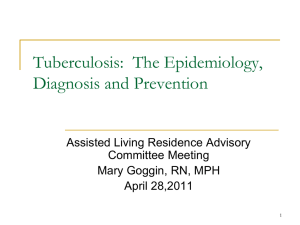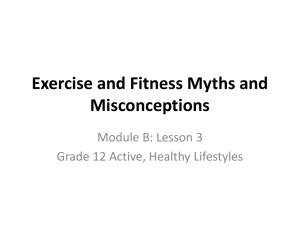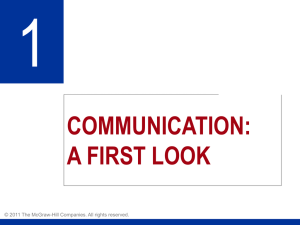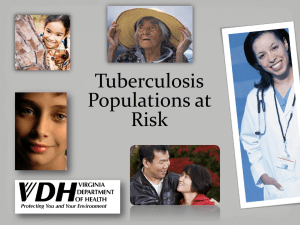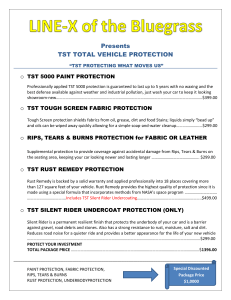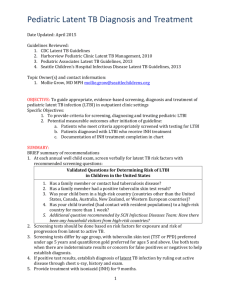Updated School TB Screening Policy
advertisement
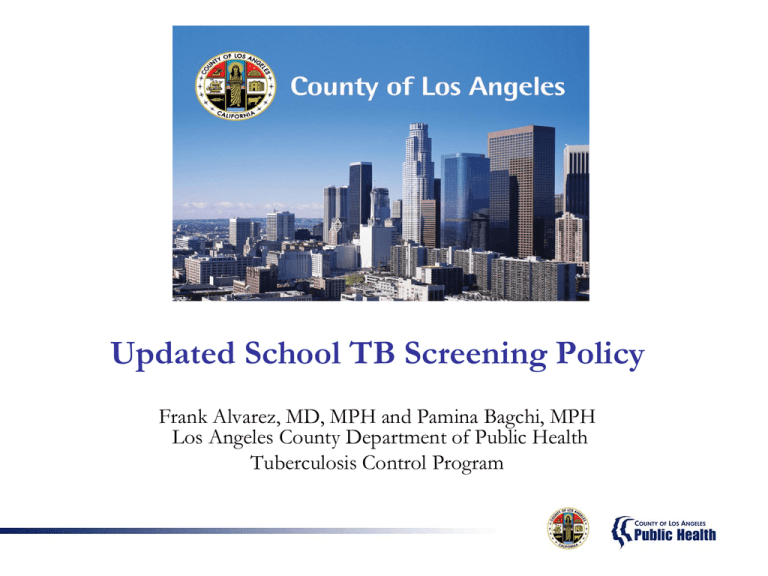
Updated School TB Screening Policy Frank Alvarez, MD, MPH and Pamina Bagchi, MPH Los Angeles County Department of Public Health Tuberculosis Control Program Topics • Background • Data • Myth-Busting • New Approach • Questions Introduction In 1980, amended California Administrative Code, Title 22, Division 22, Chapter 9, Sections 41301-41329 to enable the Local Health Officer to mandate tuberculosis (TB) testing of school children, if deemed necessary, for that specific jurisdiction. Introduction (2) From 1985-2011, the TB Control Program has required all kindergartners and students who have never previously attended school in California to provide written documentation of a TB skin test (or IGRA) result. Purpose of Previous Pre-K TB Testing Requirement • To collect County-wide data to assess improvement in TB control and better understand the presence of TB infection and disease • To determine the impact of immigration patterns on local TB incidence Purpose of Previous Pre-K TB Testing Requirement (2) • To identify children who are candidates for treatment of latent TB infection (LTBI) • To measure annual TB infection rates in the school-aged population TB Skin Test Results Among New School Entrants (K-12) and TB Cases (4-18 year old) in Los Angeles County 1993-2009 Number of TB Cases % of TST (+) 2500 2000 30% 72 53 FB_Cases(4-18 Y.O.) US_Cases(4-18 Y.O.) US_TST(+) FB_TST(+) Total_cases 25% 56 47 37 34 1500 20% 35 47 40 39 26 21 38 20 1000 33 30 34 25 27 27 15% 27 20 18 13 15 28 20 18 15 11 13 26 500 10 10% 17 5% 0 0% 93 94 95 96 97 98 99 00 01 02 03 04 05 06 07 08 09 7 Myth 1 About TB •Myth: Being infected with TB (positive skin test or blood test) means you have active TB disease. •Fact: Infection does not necessarily mean disease. TB Infection TB Disease Does not feel sick Has no symptoms Cannot spread TB bacteria to others Usually has a positive skin test or blood test Has a normal chest x-ray and a negative sputum smear Usually feels sick Has symptoms May spread TB bacteria to others Usually has a positive skin test or blood test May have an abnormal chest x-ray, and/or positive sputum smear, and/or positive culture Needs treatment for active TB disease Needs treatment for TB Infection to prevent developing active TB disease Myth 2 About TB • Myth: TB testing is the same as TB screening. • Fact: Testing for TB is not the same as screening. TB Screening TB Testing Risk assessment (series of questions) performed by clinician If deemed higher risk, test for TB infection is done Skin test (TST) or blood test (QFT or T-Spot) If positive, then chest x-ray is done Myth 1 About Previous Testing Requirement • Myth: The Pre-K Testing Requirement was used as a method of finding children with active TB disease. • Fact: The requirement was designed to determine / monitor TB infection rates, NOT to find and treat active TB disease cases. TB Control utilizes contact investigations to find active TB cases of all ages. Myth 2 About Previous Testing Requirement • Myth: The Pre-K Testing Requirement was an effective means of getting TB-infected children treated. • Fact: Monitoring was not in place to ensure that children who tested positive for TB infection began treatment. Evidence suggests that many who did begin treatment did not complete the full treatment regimen. Myth 3 About Previous Testing Requirement • Myth: If the requirement were not in place, there would be a rise in pediatric TB cases in LA County. • Fact: Jurisdictions that either rescinded their Pre-K Testing Requirement, like Riverside County, or that never had a Pre-K Testing Requirement, like San Diego County, have continued to see a steady decline in pediatric TB cases. New Requirement • Rescind the testing requirement for children entering kindergarten or a California school for the first time. • Incorporate universal TB screening and riskbased testing in existing California State physical examination requirement for children entering first grade. New Requirement (2) • Health providers, as part of this routine health assessment, will screen students and test them for TB only if a risk factor is present. New Requirement (3) Screening for High Risk TB Testing Additional Office Visits Needed? When? Old Policy New Policy None All Students All Students Only those at high risk Likely Not likely Entering Kindergarten (same as physical exam) Entering First grade 5 Factors to Assess High Risk for TB If any of these is “Yes” TST or IGRA • Birth outside US in high-prevalence region • Travel to high-incidence country > 1 week 16 Factors to Assess High Risk for TB (2) If any of these is “Yes” TST or IGRA • Contact with confirmed or suspected TB case • Family member with positive TST Why the Change? • To promote evidence-based best practice, as recommended by the CDC, AAP, USPSTF, etc. • To avoid redundancy and prevent fragmented care • To prevent false positive children from receiving treatments that may harm their livers Why the Change? (2) • To focus on placing children in medical homes • To focus on more effective interventions (e.g. CI) • To focus on higher-risk populations (e.g. homeless) Partners • Los Angeles County Office of Education (LACOE) • Los Angeles Unified School District (LAUSD) • American Academy of Pediatrics, Local Chapter (AAP) • American Academy of Family Practice, Local Chapter (AAFP) • Los Angeles County Medical Association (LACMA) • American Lung Association in California (ALAC) Partners (2) • Child Health and Disability Prevention (CHDP) • Maternal, Child and Adolescent Health (MCAH) • Los Angeles County Department of Health Services (DHS) • CA Department of Public Health, TB Control Branch (TBCB) • Long Beach Department of Health, Human Services (LBHHS) • Long Beach Unified School District (LBUSD) For Information on IGRAs • Cellestis, a Qiagen Company (QuantiFERON Gold In-Tube) Nancy Hyland nhyland@cellestis.com (661)289-2557 • Oxford Immunotec (T-SPOT) Deneen Jackson djackson@oxfordimmunotec.com (619)887-6109 TB Control Program Website TB Control Program Website Questions? LA County TB Control Program Website www.publichealth.lacounty.gov/tb/ Chhandasi Pamina Bagchi, MPH Policy and Planning, TB Control Program cbagchi@ph.lacounty.gov (213) 745-0836




